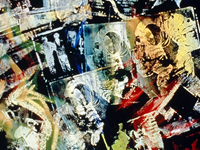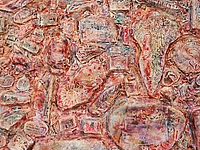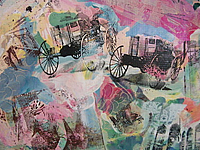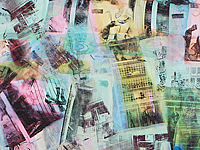Nazim Ozel has developed and invented several painting and sculpture techniques that are one of a kind in the world. Below are brief descriptions of his techniques

1) OOPS (Ozel’s Oil Painting Special)
Developed in the early 1980s,OOPS involves a process of building many layers of oil – based paints with specific drying periods between each layer.
The paint is applied with brushes using very sensitive blades and halftone plates. Frosted Mylar litho-acetate and page films are used as the base. The technique is involved and varies from piece to piece. First an abstract expressionistic background composition is painted and then the images are transferred individually with halftone and graphic plates.

2) ART (Acrylic Relief Transfer) Paintings
Invented in the early1990s, this technique involves many steps. First, a meticulous relief model is created in clay using halftone and graphic plates. The clay model is transferred on hydra stone.
Next another mold is taken. Employing various painting techniques, the laid-out relief images and graphics are highlighted and colored by very sensitive brush work in many layers. In the final process, the images are transferred onto canvas. The work is completed by further brush work on the transferred surface. With varied techniques, each mold maybe used for a number of different works to create a series of unique piece.

3) ARTS (Acrylic Relief Transfer Sculptural)
Developed during the mid-1990s, this is the sculptural version of the acrylic relief transfer paintings.
The relief is modeled in clay by adding the surface imagery and ornamentation as it is applied in the acrylic relief transfer. Again, a mold is taken from the clay and the relief is directly built on the final mold employing acrylic, super-gel, texture compound, fiber glass, fabric and wood.

4) AFTR (Acrylic Flat Transfer)
Developed in the early 2000s, this technique involves the over lapping of two compositions on frosted Mylar or polyethylene surfaces.
First composition is applied using halftone plates primarily with darker colors. Next a color field composition is over laid onto the first composition primarily with lighter colors. After the completion of these over lays they are transferred onto canvas or screen.

5) ANT (Acrylic And Transfer)
ANT is recent technique developed over the past two years. ANT involves overlapping and combining several compositions on frosted Mylar, various papers, and other flat surfaces.
The first composition involves transferring images with halftone and graphic plates primarily using darker colors. The next composition is overlapped onto the first composition by primarily transparent colors followed by further brushwork with opaque colors. Completed works are preserved on these surface.